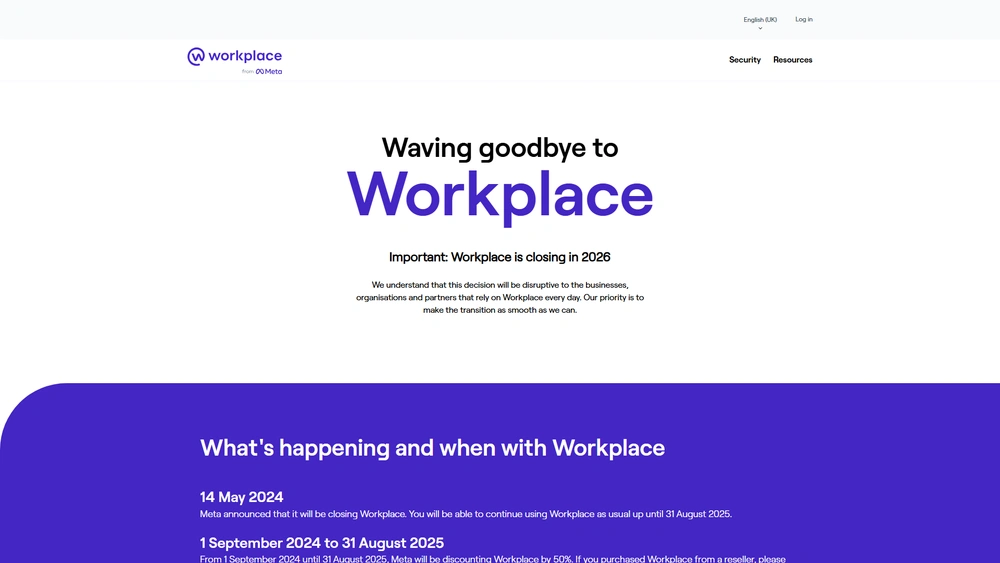Workplace from Meta Overview & 2025 Industry Position
Workplace from Meta, a business communication platform developed by Meta Platforms, has steadily evolved from a Facebook-style intranet into a robust enterprise-grade collaboration system. Positioned at the crossroads of user-first design and secure productivity, Workplace from Meta enters 2025 with a clearly sharpened focus: delivering AI-enhanced, people-connected operations at scale. As hybrid work environments mature and digital transformation initiatives accelerate globally, the platform continues to carve out a distinct value proposition—one combining Meta’s strength in human-centric technology with a commitment to secure, scalable tools for business operations.
From Launch to 2025: Workplace from Meta’s Journey
Originally launched as Facebook at Work in January 2015, Workplace was rebranded in 2016 to distinguish its enterprise focus. Its major evolution points include:
- 2016: Official public launch with core collaboration tools
- 2018: Introduced live video broadcasting and integrations with Microsoft Office
- 2020: Surge in usage during COVID-19 and rollout of Knowledge Library
- 2021: Tightened integrations with Zoom, ServiceNow, and Workplace Rooms
- 2023: AI initiative launched to automate workflows and enhance personalization
- 2025: Focus on AI-native communication, compliance-first messaging, and industry-specific use cases
The 2025 strategic thesis: Workplace from Meta aims to be the intelligent neural layer of enterprise communication, blending automation, culture, and compliance in one secure stream.

Workplace from Meta Key Features
Workplace combines a familiar social network-style interface with powerful enterprise features:
- Workplace Chat: Encrypted real-time messaging, now with Meta AI integration
- Live Video: Broadcast CEO town halls or team updates securely
- Groups: Flexible spaces for teams, functions, or cross-org collaboration
- Knowledge Library: Centralized company policies and resources in searchable hub
- Auto-translations: Real-time multi-language support for global teams
- Meta AI Assist: Summarize conversations, organize files, or answer HR questions on Slack-like threads
- Mobile-first experience: Fully functional native apps for Android and iOS with mobile support parity
Workflow & UX Design
Workplace from Meta prioritizes intuitive, mobile-friendly workflows. The platform is deliberately modeled after social networks, reducing the learning curve across generations and regions. Navigation is minimalist—sidebar groups, feed-centric layout, and persistent chat across mobile and desktop. AI now surfaces relevant threads or documents proactively, while admins enjoy low-friction controls for community rules, permissions, and integrations.
Pro Tip: Utilize smart groups with auto member rules by department or location to streamline onboarding and reduce manual setup.
Workplace from Meta Pricing Analysis & Value Metrics
| Plan | Cost (per user/month) | Includes |
|---|---|---|
| Essential | $4 | Groups, Chat, News Feed, Live Video, Knowledge Library |
| Enhanced | $8 | Everything in Essential + Integrations, Meta AI Assistant, Admin Controls |
| Enterprise | Custom | Custom SSO, Compliance APIs, Dedicated CSM, Custom Integrations |
Value Outlook: The Essential plan makes it appealing for cost-conscious SMBs. For larger orgs, Enhanced brings workplace automation and compliance-ready tooling below Salesforce Chatter or Yammer pricing.
Competitive Landscape
| Platform | Key Advantage | Best For |
|---|---|---|
| Microsoft Teams | Office 365 ecosystem | Enterprises already on Microsoft stack |
| Slack | Developer workflows and automations | Tech-focused teams and startups |
| Workplace from Meta | Human-first UI + AI + Compliance blend | Retail, frontline teams, hybrid orgs |
Use Cases that Fit Well
- Retail & Frontline: Managers use Live Video for announcements; staff use Mobile Chat
- Healthcare: HIPAA-compliant internal updates and resource knowledge sharing
- Non-profits: Cross-border collaboration made seamless with auto-translations
- Multi-office Enterprises: Better engagement and flattened hierarchies through transparent communication
Ecosystem & Integrations
Workplace integrates with hundreds of enterprise apps. Shortlist includes:
- CRM: Salesforce, Zendesk
- HR & Payroll: Workday, Gusto, BambooHR
- Meetings: Zoom, Webex, Google Meet
- Cloud Storage: Dropbox, Google Drive
- Project Management: Jira, Trello, Asana
Single Sign-On support, custom APIs, and prebuilt Zapier connectors ease extensibility.
Pros & Cons
- Pros:
- Familiar UX from Facebook heritage reduces ramp-up time
- Broad language support for international teams
- Low-barrier pricing, especially for frontline and nonprofit sectors
- Robust AI features at scale (vs Slack AI rollout delays)
- Cons:
- Limited developer APIs compared to Slack
- Perception challenge: “Facebook for work” stigma in some industries
- Still catching up with Microsoft Teams on document co-editing features
Final Thoughts
Workplace from Meta is a surprising star in 2025’s collaboration landscape. Its success stems less from being flashy and more from aligning with how people prefer to interact—socially, visually, and mobile-first. For companies seeking compliance-ready communication, out-of-the-box usability, and seamless integration across cultures and devices, Workplace from Meta hits a unique sweet spot. That said, power-users or engineering-heavy teams may still lean toward Slack or Teams.
Workplace from Meta FAQ
Yes, the Enterprise tier includes HIPAA support and necessary compliance controls for healthcare organizations.
Absolutely. The iOS and Android apps mirror full desktop functionality, making the platform ideal for frontline or remote-only teams.
Meta AI Assistant helps summarize discussions, schedule meetings, extract action items, and recommend resources based on contextual queries.
Yes, Workplace offers discounted or no-cost access for eligible nonprofit organizations under its social impact initiative.
Yes, Workplace offers partner solutions and built-in tools for migrating core content, chat history, and user groups from Slack and Teams.